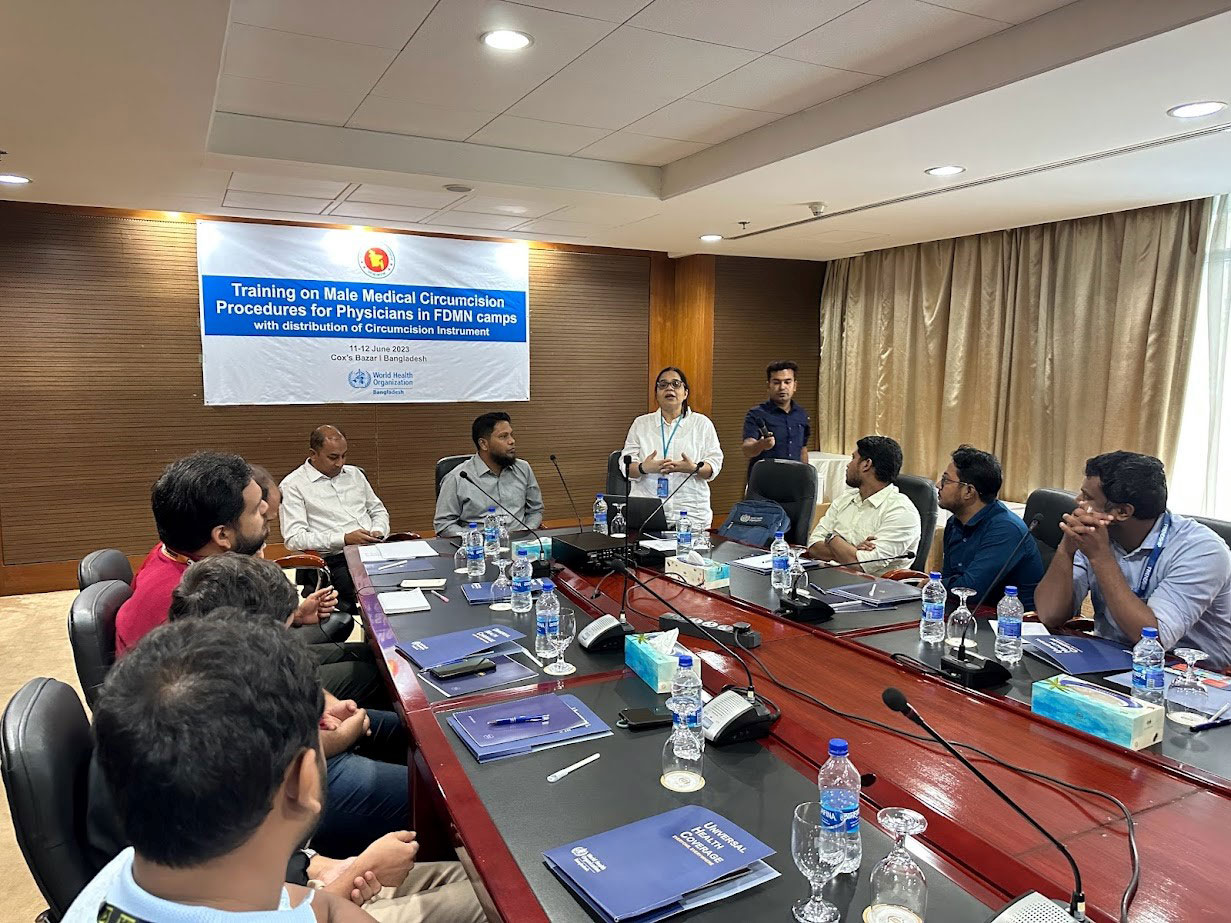“I am very happy with the quality and safety of the circumcision service that TDH Primary Health Care provided for my son. His health and happiness are the most important things to me. Before, I had to use local alternatives for my other children, which were expensive and risky. But now, I have peace of mind knowing that my son received the best care possible,” said Md Karim, father of 6-year-old Nur Faisal.
About 98% of Rohingya refugees are Muslims who practice circumcision for their children as part of their faith and culture. However, in the refugee camps, few healthcare facilities offered this service. As a result, many refugees had to rely on untrained and unsanitary providers, which exposed their children to the risk of infections like Hepatitis B and C.

6 years old Nur Faisal and his father pose after a safe and voluntary male circumcision in one of the 8 healthcare facilities identified and supported by WHO for this purpose.
Photo Credit: WHO/ Mowla S M Niaz
“The establishment of new circumcision centers in Cox’s Bazar is a significant milestone for the health sector response to this humanitarian crisis. WHO has been instrumental in facilitating this process, in collaboration with the Government of Bangladesh and other partners. We have not only improved the access and quality of circumcision services but also reduced the risk of infections and complications among the Rohingya population,” said Dr Bardan Jung Rana, WHO Representative to Bangladesh.
The World Health Organization (WHO) recognized the urgent need for change and sprang into action. WHO developed a three-part concept of operations to address this issue comprising support health sector partners to establish new dedicated circumcision centers, procurement of essential equipment for circumcision procedures, and capacity building.

WHO trains Medical Officers from identified healthcare facilities on theoretical perspectives of circumcision.
Photo Credit: WHO/ Mowla S M Niaz
To cover the entire Rohingya population, eight health facilities were identified geographically representing the different regions. Five of these facilities are in Ukhiya and the other three are in Teknaf. In partnership with the State Department’s Bureau for Population, Refugees, and Migration (BPRM), WHO supported the procurement of surgical instruments for circumcision procedures to facilitate the establishment of these eight new circumcision centres. By April 2023, all related surgical instruments were procured and distributed to the eight identified health facilities.
Two Medical Officers from each selected health facility received training from Professors of General Surgery from the National program and the WHO Communicable Diseases Officer. This training focused on both theoretical and practical perspectives of circumcision.
 WHO trains Medical Officers from identified healthcare facilities on theoretical perspectives of circumcision.
WHO trains Medical Officers from identified healthcare facilities on theoretical perspectives of circumcision.
Photo Credit: WHO/ Mowla S M Niaz
“This is a remarkable achievement for the health and well-being of the Rohingya population in Cox’s Bazar. WHO is proud to support the Government of Bangladesh and our partners in providing safe and quality circumcision services to the refugees and host communities. This is a testament to our collective commitment to leave no one behind,” said Dr Jorge Martinez, Head of WHO Emergency Sub Office, Cox’s Bazar. Nur Faisal and 412 others were circumcised in these centres from June to August 2023. This activity encouraged the Rohingya population to seek circumcision procedures in the selected health facilities and limited going to traditional healers/ Hazam, which ultimately decreased the rate of infection.
To ensure the acceptance and utilization of circumcision centers, WHO encouraged community involvement. Facilities were encouraged to bring Community Health Workers (CHWs) to the centres so they could interact with the FDMNs and gain a better understanding of the activities taking place there.
Due to limited healthcare access, cultural obstacles, and low service utilization, refugees and IDPs face a high risk of various infections. Therefore, setting up new centers and training staff on circumcision procedures were important steps to enhance other strategies for a stronger health response in the Rohingya refugee camps.
With these actions, WHO has been instrumental in protecting vulnerable communities, reducing the effects of healthcare difficulties on the social and economic spheres, and supporting the recovery of the Rohingya people.

WHO provides circumcision equipment to selected health facilities in Rohingya camps.
Photo Credit: WHO/ Mowla S M Niaz
For more information on this publication, please email Terence Ngwabe Che, External Communications Officer at WHO Cox’s Bazar Office, Bangladesh, at chet@who.int
